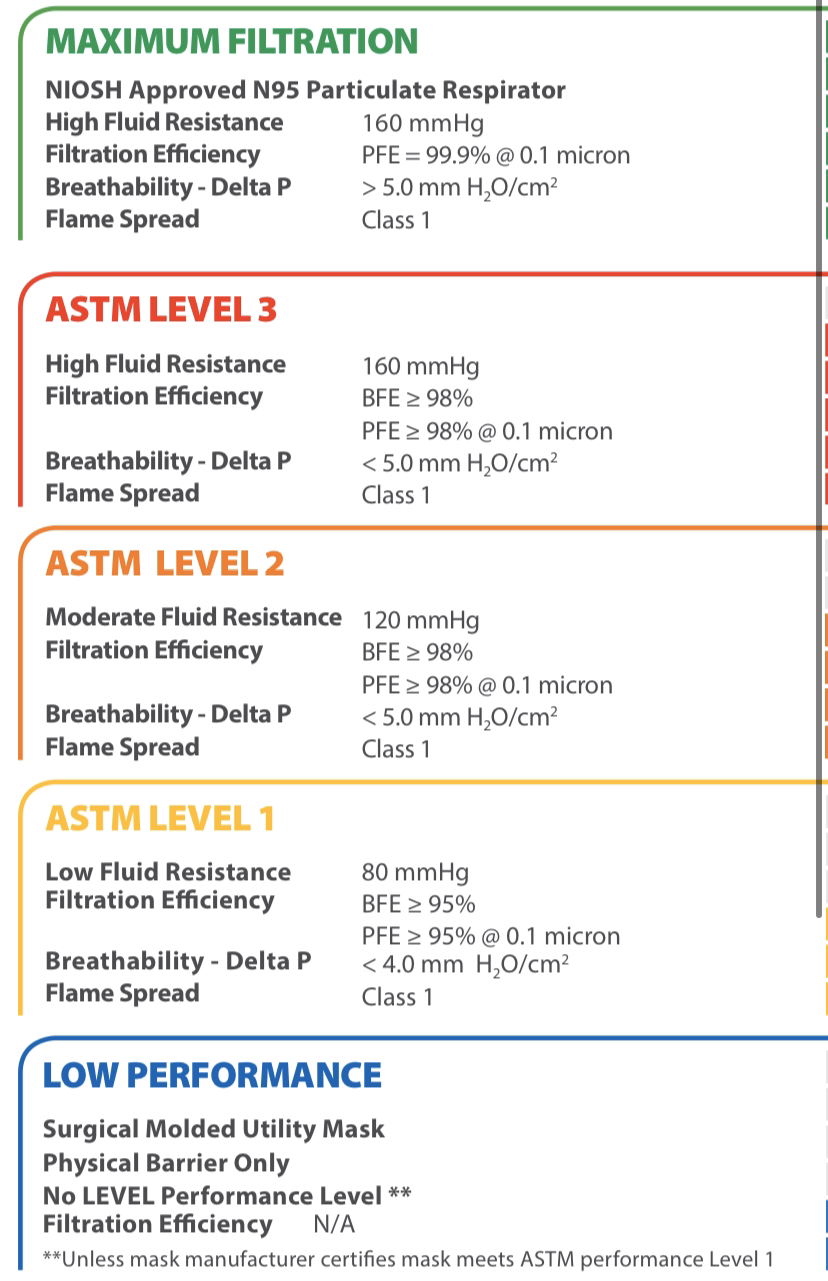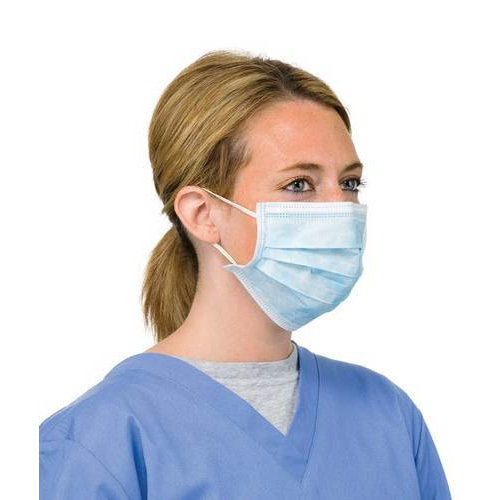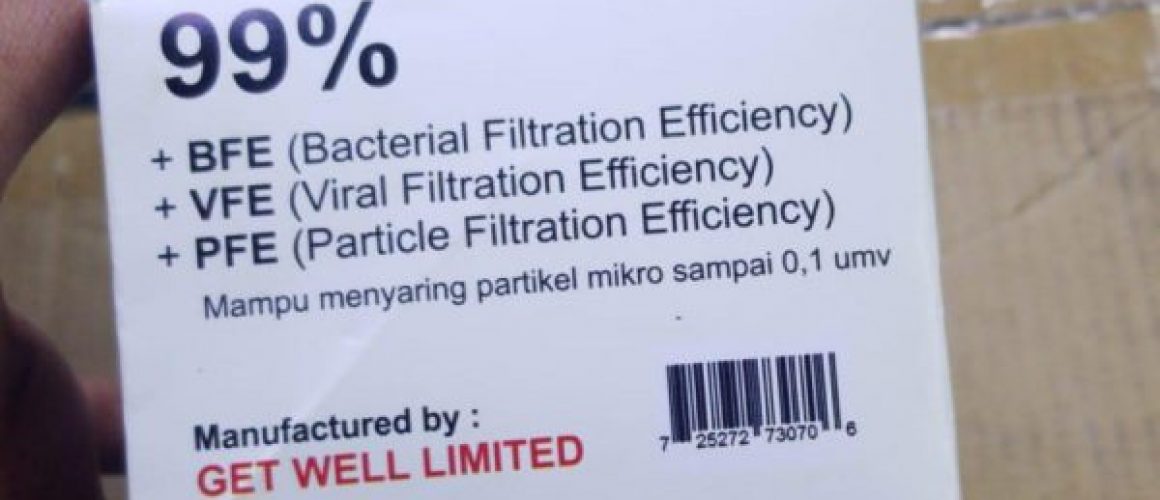Standard Terms of Face Mask
The higher the BFE value, the better the filtering effect
Fallacy: Buy a surgical mask and mark it as a 3-layer design, foolproof!
When purchasing surgical masks, in addition to choosing a 3-layer design, you can also refer to the Bacterial Filtration Efficiency (BFE) and Particle Filtration Efficiency (PFE) listed on the box.
BFE: Manufacturers use Staphylococcus aureus, which is about 3 microns in size, for testing. Bacteria particles are mostly 1 to 4 microns, so the higher the BFE value of the mask, the better the effectiveness of filtering bacteria.
PFE: Manufacturers will use 0.1 to 1 micron particles for testing. However, in order to increase the filtration success rate, manufacturers may use 1 micron particles for testing; however, influenza virus particles are 0.1 micron, so even if the PFE filtration rate of the mask is more than 90%, it does not mean that it can isolate the virus. Therefore, the reference function of the PFE value is limited.
Fallacy: N95 masks can block at least 95% of particles smaller than 0.3 microns, and wearing N95 on the street is the most stable!
Given the current situation in Hong Kong, wearing surgical masks is sufficient. However, in the event of the first confirmed case in Hong Kong, family members and medical personnel who come into contact with the patient must wear high-standard N95 masks; because the characteristics and transmission routes of the virus are not known, personal protective equipment such as protective clothing should be worn before contacting the patient , Masks, masks, gloves, etc.
Because the situation in Wuhan is still not fully understood, if you want to go to the local area, you can wear surgical masks; but if you are worried, you can also wear a better protective N95 mask.
Surgical masks can block pathogens transmitted by droplets, but N95 masks are required to block airborne pathogens. It is temporarily unclear whether this new type of coronavirus can be transmitted through the air. On very dry days, due to the low humidity, when the particles or droplets carrying pathogens evaporate in the air, the water particles of these pathogens become very small and easily float in the air, the distance can be far more than 1 foot. Another possibility is that it originated from a specific environment, such as the SARS epidemic that year, there were hospitals using nebulizers in the ward, and the SARS virus was then scattered in the air.
Fallacy: For environmental protection, wear cotton masks.
The filtering effect of the mask depends on the fiber size, the smaller it can block the virus particles. Surgical masks consist of 3 layers of non-woven fabric, the filter layer has a fiber diameter of 2 to 5 microns, and has a blocking rate of 40% to 50% for virus particles of 0.1 microns. As for cotton masks, the diameter of the cotton rope structure fiber is 500 to 1000 microns, which not only cannot filter virus particles, but also difficult to prevent bacterial particles. It can only filter dust mites above 200 microns.

Wet, wear mask for more than 8 hours
Fallacy: It doesn’t matter if you wear a mask all day.
Surgical mask fibers are electrostatically attached to absorb virus particles. However, when wearing a mask for a long time, the face sweats, dissolving the static electricity of the fiber, and weakening the adsorption function of the mask. Static electricity makes it difficult for masks to filter viruses. ” Therefore, once the mask becomes wet or worn for more than 8 hours, it needs to be replaced.
Fallacy: Surgical masks use color to distinguish the bottom, with the colored side facing outwards; monochrome masks have no bottom.
To distinguish between the bottom of a mask, you must first understand how the bottom surface functions differently. The outer layer of the surgical mask is waterproof (Hydrophobic) to prevent the penetration of viruses or bacteria in the water; the bottom material is Hydrophilic, which absorbs the water vapor exhaled by the human body, making the user more comfortable.
Therefore, to distinguish the underside of the mask, it is recommended to sprinkle a little water on both sides and observe which side absorbs water. However, many manufacturers now use waterproof materials to make the bottom surface of masks in order to save costs, making the bottom layer of the mask unable to absorb water; if it is found that neither side of the mask can absorb water, the mask has no bottom surface.
Conformal stereo mask with better defense
Fallacy: Three-dimensional masks are just good-looking, and less effective at blocking viruses than surgical masks.
The three-dimensional mask covers a larger area than surgical masks, and the side is more conformable. However, its protective effect also depends on whether the material of the mask is the same as that of the surgical mask, and whether there is a metal strip at the position of the bridge of the nose. The importance of the metal strip is to keep the upper end of the mask close to the face to prevent bacteria or viruses from entering through the gap.
3D three-dimensional masks have better defense capabilities, and the reason is related to wind speed. Compared with flat masks, three-dimensional masks have a larger area, which can reduce wind speed, make particles below 1 micron stay in the air for a longer time, more easily adhere to the mask, and reduce the risk of patients directly inhaling virus particles.

Activated carbon only smells and does not block the virus
Fallacy: 4-layer activated carbon masks have better barrier effects than 3-layer surgical masks.
Activated carbon is used to absorb odors, such as formaldehyde, and cannot block viruses and bacteria. Therefore, after adding activated carbon material to the mask, the filtering effect cannot be improved.
Fallacy: The larger the mask, the more it covers, and the stronger the protection.
The mask is too large. For example, children wear adult masks. Many times there are many gaps. Bacteria or viruses can enter through the gaps. In addition, the faces of children are smaller, and the metal strips of the masks may not fit. Conversely, a mask that is too small is not appropriate, and it does not completely cover the mouth, nose, and chin, which weakens the protection. The size of the mask should be close to the face, and fit the face shape.
When wearing surgical masks, if there are gaps on both sides of the cheek, about 20% of the air cannot be filtered, which weakens the filtering efficiency.
Fallacy: Japanese masks have many styles and high protection.
When purchasing a mask in Japan, you must also pay attention to the number of mask layers and the effect of bacterial filtration. It is best to understand the Japanese description on the package. Some Japanese masks use 4 or 5 layers of design, claiming to add a moisturizing layer, these may be gimmicks. However, if there is additional effectiveness, it may be necessary, such as sensitive people or need to choose a mask with a low-sensitivity material inside. When choosing a mask, the most important thing is the filter layer in the middle layer, which can block bacteria, dust, and anti-fouling and waterproof materials in the first layer.
Source: 明報健康網




